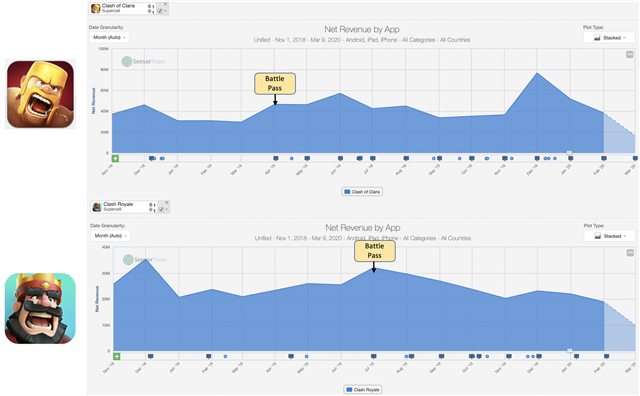Supercell’s Battle Pass Clash: A Tale of Two Economies
This analysis is a part of Deconstructor of Fun’s Digest newsletter. You can sign up to the newsletter at the bottom of this text.
Since Fortnite’s popularization of the battle pass system, almost every game company has considered incorporating a similar monetization feature into their games. Unfortunately, the copy+paste mentality of the games industry has failed to fully comprehend the situational context of how and when to implement battle pass successfully.
As a case study, consider Supercell, one of the first to integrate battle passes into their mobile games, and such integrations led to both success (Clash of Clans) and failure (Clash Royale).
Note: Both games saw ~20% decline in downloads during this period.
Source: Sensor Tower
Why did battle pass design succeed in one game and not the other?
It’s all about content depth! Battle pass systems depend on presenting a highly desirable set of content unlocks.
In the case of cosmetics-based battle pass systems like Fortnite, creating such content requires generating visually compelling characters, costumes, and other cosmetics (all with no impact to gameplay power) over and over again. Keeping this hungry pipeline robust with quality content, however, is no small feat. This is why Fortnite often integrates very expensive brand partnerships with Batman, Star Wars, and famous streamers to keep their players hooked on their battle pass content treadmill.
In contrast, the problems of battle pass systems in non-cosmetics-based game economies like Clash of Clans and Clash Royale differ. Clash of Clan’s monetization focuses on resource building and unit training/depletion. Resource depletion economies work fantastically with battle pass because of how much easier it is to design currency sinks in multiple ways.
Compare Clash of Clan’s resource depletion economy to a gacha collection economy, like the one found in Clash Royale. CR’s battle pass has not been revenue accretive for the game because the collection depth in Clash Royale caps out relatively quickly (unit level 13–14). Hence, by offering multiple gacha pulls through battle pass at a steep discount to their normal price in-store, players will have increasingly lower incentive to pay full price for gacha pulls via direct store purchase. Moreover, the introduction of trade tokens has allowed players to trade with clan members to get the exact card copies they want, further exacerbating the problem. Players are decreasingly incentivized to pay full price for gacha pulls to upgrade specific units because they can just trade for them.
At a high level, game designers must first deeply understand their game’s economy when weighing what kind of impact a battle pass system could have on such an economy. Without fully considering second- and third-order effects from these important situational contexts, battle passes can cause long-lasting impacts to a game’s future revenue stream.






